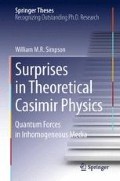Abstract
In his quantum theory of light, Dirac proposed a quantisation of the electromagnetic field, as described by Maxwell’s equations. We briefly propound a simple version of quantum electrodynamics that is suitable for describing some of the effects of quantised electromagnetic fields in media, and determine an expression for the Casimir stress between two interacting objects embedded in a fluid.
Photon, photon, shining bright! Diffracting through the lab. at night. Can even God, with all his might, measure thy position right?
The author
Access this chapter
Tax calculation will be finalised at checkout
Purchases are for personal use only
Notes
- 1.
Monochromatic modes are stationary modes that conserve energy. We therefore expect the Hamiltonian to be the sum of the Hamiltonians of the individual modes.
- 2.
See Sect. 1.1.2.
- 3.
- 4.
See Appendix B and [21].
- 5.
The accepted use of the ‘Minkowski-like’ stress tensor for computing Casimir forces in the Lifshitz theory [22] was challenged in [23], resulting in some debate [13, 24, 25]. A new argument for the disputed result can be found in [3], where the Casimir stress was derived in the context of the canonical theory of macroscopic quantum electrodynamics [4].
- 6.
Lifshitz theory, in this case, refers to the more general results obtained in [12].
- 7.
This result is not valid when there is absorption. Note that the expression for the variation of the free energy in Lifshitz theory takes a similar form [12]:
$$ \delta F=\delta F_{0}-\frac{T}{4\pi }\sum _{n=0}^{\infty }\int D_{ii}(\mathbf {r},\mathbf {r},\xi _{n})\delta \epsilon (\mathbf {r},i\xi _{n})\text {d}^{3}\mathbf {r}. $$ - 8.
We note that the first contribution \(\mathbf {f}_{P}\) contains a pressure term which is present in the absence of electromagnetic fluctuations, and a contribution due to the deformation of the medium which vanishes in the limit of an incompressible medium.
- 9.
- 10.
For a discussion of Wick rotation to the imaginary axis, see Appendix A.
- 11.
The full details of this approach can be found in [1].
- 12.
In the limit as \(x'\rightarrow x\), this amounts to subtracting the self-interacting terms. Only waves which have explored the environment contribute to the Casimir force.
- 13.
- 14.
Metamaterials incorporate arrays of micro-engineered circuitry, and can be engineered to produce a strong magnetic response at certain frequencies.
References
U. Leonhardt, Essential Quantum Optics (Cambridge University Press, Cambridge, 2010)
J.D. Jackson, (Wiley, New York, 1998)
T.G. Philbin, New. J. Phys. 13, 063026 (2011)
T.G. Philbin, New J. Phys. 12, 123008 (2010)
E.M. Lifshitz, Zh. Eksp. Teor. Fiz. 29, 94 (1955)
S.M. Rytov, V.I. Kravtsov, Y.A. Tatarskii (eds.), Principles of Statistical Radiophysics. Wave Propagation Through Random Media. vol. 3 (Springer, Berlin, 1989)
F.S.S Rosa, D.A.R Dalvit, P.W Milonni, Phys. Rev. A 81, 033812 (2010)
S.Y. Buhmann, D.-G. Welsch, Prog. Quantum Electr. 31(2), 51–130 (2007)
S.Y. Buhmann, Acta Phys. Slovaca 58(5), 675–809 (2008)
S.Y. Buhmann, Dispersion Forces I. (Springer, Heidelberg, 2013)
R. Kubo, Rep. Prog. Phys. 29(1), 255 (1966)
I.E. Dzyaloshinskii, E.M. Lifshitz, L.P. Pitaevskii, Adv. Phys. 10, 165 (1961)
L.P. Pitaevskii, Phys. Rev. A 73, 047801 (2006)
L.P. Pitaevskii, in Casimir Physics, ed. by D. Dalvit, P. Milonni, D. Roberts, F. da Rosa. Lecture Notes in Physics, vol 834 (Springer, Berlin, 2011), pp. 23-37
L.D. Landau, E.M. Lifshitz, Electrodynamics of Continuous Media (Pergamon Press, Oxford, 1960)
T.G. Philbin, C. Xiong, U. Leonhardt, Ann. Phys. 325, 579 (2009)
T.H. Boyer, Phys. Rev. A 9, 2078 (1974)
F.S.S. Rosa, J. Phys. Conf. Ser. 161(1), 012039 (2009)
S.J. Rahi, T. Emig, Phys. Rev. Lett. 105, 070404 (2010)
S.J. Rahi, T. Emig, R.L. Jaffe, in Casimir Physics, ed. by D. Dalvit, P. Milonni, D. Roberts, F. da Rosa. Lecture Notes in Physics, vol 834 (Springer, Berlin, 2011), pp. 129–174
D.J. Griffiths, Introduction to Electrodynamics, vol. 3 (Prentice Hall, Upper Saddle River, NJ, 1999)
A.D. McLachlan, Mol. Phys. 7(4), 381 (1964)
C. Raabe, D.-G. Welsch, Phys. Rev. A 80, 067801 (2009)
I. Brevik, S.A. Ellingsen, Phys. Rev. A 79, 027801 (2009)
C. Raabe, D.-G. Welsch, Phys. Rev. A 71, 013814 (2005)
E.I. Kats, Zh. Eksp. Teor. Fiz. 73, 774 (1977)
A. Lambrecht, A.C. Duran, R. Guerout, S. Reynaud, in Casimir Physics, ed. by D. Dalvit, P. Milonni, D. Roberts, F. da Rosa. Lecture Notes in Physics, vol 834 (Springer, Berlin, 2011), pp. 97–127
Author information
Authors and Affiliations
Corresponding author
Rights and permissions
Copyright information
© 2015 Springer International Publishing Switzerland
About this chapter
Cite this chapter
Simpson, W.M.R. (2015). Macroscopic Quantum Electrodynamics. In: Surprises in Theoretical Casimir Physics. Springer Theses. Springer, Cham. https://doi.org/10.1007/978-3-319-09315-4_2
Download citation
DOI: https://doi.org/10.1007/978-3-319-09315-4_2
Published:
Publisher Name: Springer, Cham
Print ISBN: 978-3-319-09314-7
Online ISBN: 978-3-319-09315-4
eBook Packages: Physics and AstronomyPhysics and Astronomy (R0)

